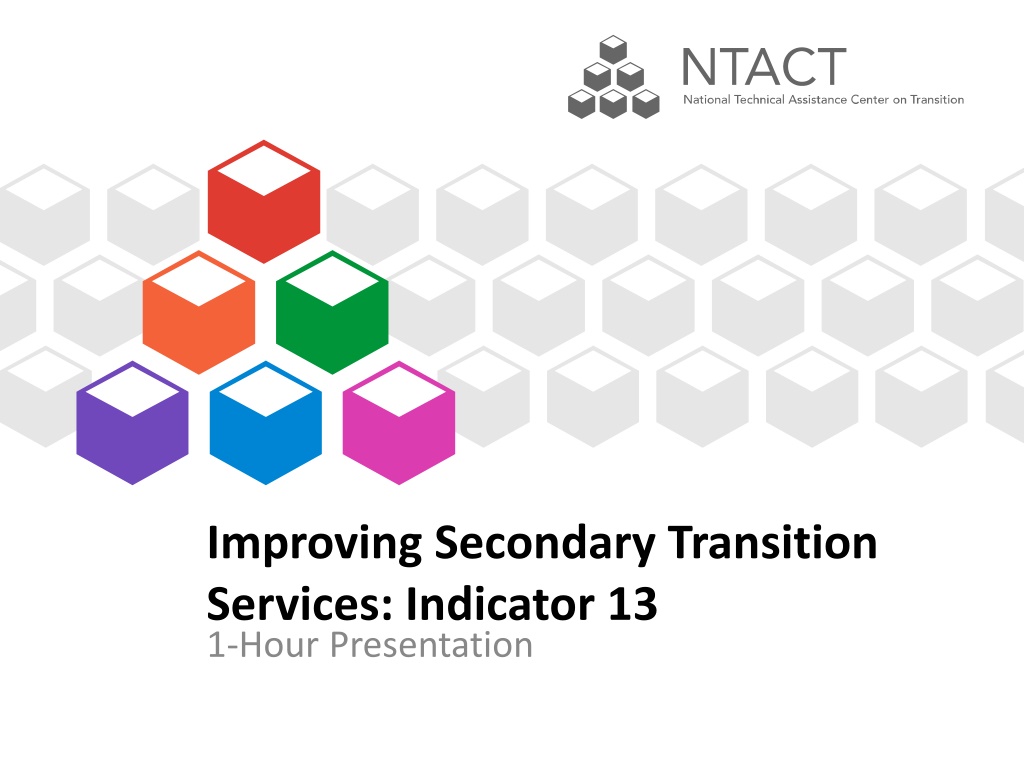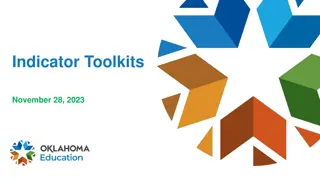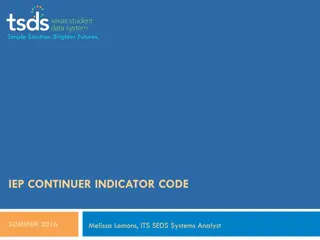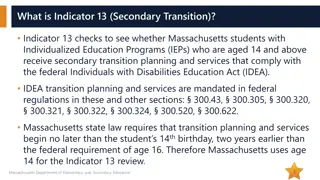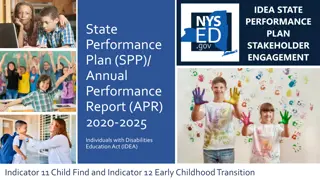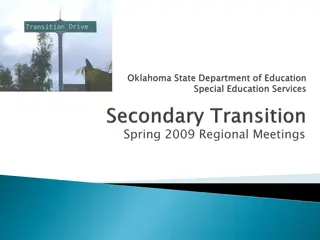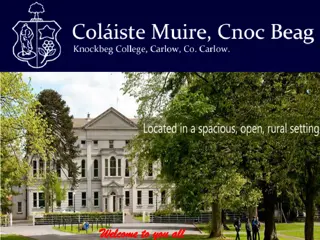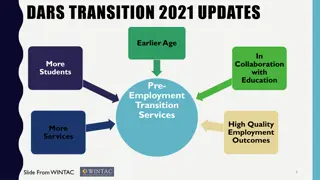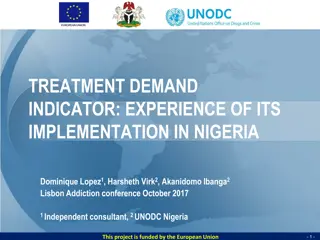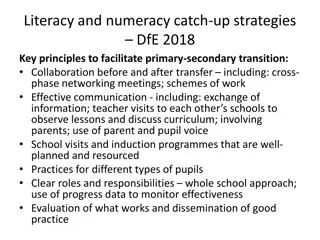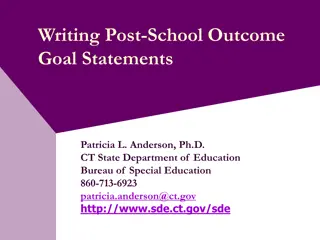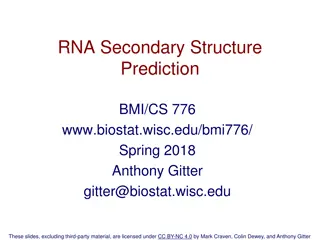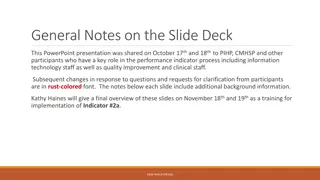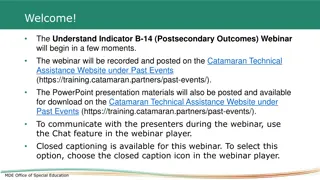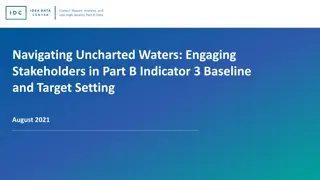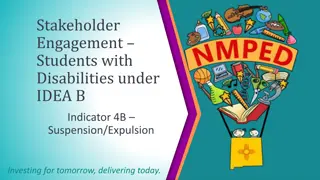Enhancing Secondary Transition Services: Key Strategies for Indicator 13 Implementation
Learn about the essential components of Indicator 13 in secondary transition services, including transition assessment, goal-setting, alignment of IEP goals, and coordination for successful student outcomes. Discover why transition assessment is crucial, how it informs the planning process, and the importance of collaboration between educators, families, and students. Gain insights from the Seattle University Center for Change in Transition Services and practical tools for effective transition planning.
Download Presentation

Please find below an Image/Link to download the presentation.
The content on the website is provided AS IS for your information and personal use only. It may not be sold, licensed, or shared on other websites without obtaining consent from the author. Download presentation by click this link. If you encounter any issues during the download, it is possible that the publisher has removed the file from their server.
E N D
Presentation Transcript
Improving Secondary Transition Services: Indicator 13 1-Hour Presentation
Agenda for Todays Meeting Indicator 13 and Transition Law Meeting Indicator 13 Requirements Transition Assessment Writing Postsecondary Goals Transition Services Course of Study Aligning Annual IEP Goals Evidence of Coordination Student Invitation 2
Materials for Todays Meeting Indicator 13 Checklist A and/or B Handout of formulas for writing postsecondary goals and annual IEP goals 3
Seattle University- Center for Change in Transition Services, 2010
Why Transition Assessment? Transition Assessment is the ongoingprocess of collecting data on the student s needs, preferences, and interests as they relate to the demands of current and future working, educational, living, personal, and social environments (Sitlington & Payne, 2004) 5
Key to Successful Transition Planning: Transition Assessment Assessment data serve as the common thread in the transition process Forms the basis for defining goals and services to be included in the Individualized Education Program (DCDT, 2013) 6
Transition Assessment is strengthened. When teachers across the curricula collaborate to conduct transition assessments related to specific content areas When families and students are involved in the process
Allison Transition Assessment Documentation AIR Self-Determination Assessment Informal interviews Career Employment Education Checklist School career planning survey for juniors School Parent Survey Parent Interviews Postsecondary Vision Be more organized Go to a four-year college and succeed Work with young children Allison Allison s Parents Enroll in a college program that will help her achieve her career goals Find a school and social life balance Met college entrance and state testing requirements (to date) Additional Assessment Data 9
Indicator 13 Percent of youth with IEPs aged 16 and above with an IEP that includes appropriate measurable postsecondary goals that are annually updated and based upon an age appropriate transition assessment, transition services, including courses of study, that will reasonably enable the student to meet those postsecondary goals, and annual IEP goals related to the student s transition services needs. There also must be evidence that the student was invited to the IEP Team meeting where transition services are to be discussed and evidence that, if appropriate, a representative of any participating agency was invited to the IEP Team meeting with the prior consent of the parent or student who has reached the age of majority. (20 U.S.C. 1416(a)(3)(B)) 10
Indicator 13 Checklist 1. Is there an appropriate measurable postsecondary goal or goals in this area? 2. Is (are) the postsecondary goal(s) updated annually? 3. Is there evidence that the measurable postsecondary goal(s) were based on an age appropriate transition assessment? 4. Are there transition services in the IEP that will reasonably enable the student to meet his or her postsecondary goal(s)? 11
Indicator 13 Checklist (cont.) 5. Do the transition services include courses of study that will reasonably enable the student to meet his or her postsecondary goal(s)? 6. Is (are) there annual IEP goal(s) related to the student s transition services needs? 7. Is there evidence that the student was invited to the IEP Team meeting where transition services were discussed? 8. If appropriate, is there evidence that a representative of any participating agency was invited to the IEP Team meeting with the prior consent of the parent or student who has reached the age of majority? 12
Indicator 13 Checklist (cont.) We will address each of the components of I- 13 in the following slides, as it relates to Allison s case study. 13
Postsecondary Goals Measurable = Countable Identifies an outcome, not a process One goal for each adult outcome area Adult Outcome Areas Education or Training (required) Employment (required) Independent Living (when appropriate) 15
Postsecondary Goal Questions Where is the student going to work or engage in productive activities after graduation? Where and how is the student going to continue to learn and/or develop skills after graduation? Where is the student going to live and how is he or she going to access adult services, participate in the community and have fun after graduation? 16
Allison Transition Assessment Documentation AIR Self-Determination Assessment Informal interviews Career Employment Education Checklist School career planning survey for juniors School Parent Survey Parent Interviews Postsecondary Vision Be more organized Go to a four-year college and succeed Work with young children Allison Allison s Parents Enroll in a college program that will help her achieve her career goals Find a school and social life balance Met college entrance and state testing requirements (to date) Additional Assessment Data 18
Allisons Examples of Postsecondary Goals Education and Training: After graduation from high school, Allison will enroll in (a four-year) college (and pursue a Bachelor s degree in Child Development). Employment: After (earning her four-year degree), Allison will obtain (full-time) employment (working with children). 19
Allisons Examples of Postsecondary Goals Independent Living: After high school, Allison will self-advocate for accommodations in college. After high school, Allison will use strategies to effectively manage her time, (so that she successfully meets her deadlines for college). 20
Updated Postsecondary Goals Is (are) the postsecondary goal(s) updated annually? 22
Allisons Example of Updated Postsecondary Goals Example: In her PLAAFP, the following is written: Allison wants to work with children after obtaining a four-year degree (junior year survey). Non-Example: Allison Will get a job after high school (same goal from her IEP in 9th grade). 23
Age-Appropriate Transition Assessment 24
Age-Appropriate Transition Assessment We began our process with transition assessments, including Ongoing assessments Age-appropriate assessments Assessments from multiple sources Formal and informal assessments 25
Types of Transition Assessment Formal and Informal 26
Transition Assessment Questions Where is the individual presently? Where is the individual going? How do we get the individual there? (Colorado DPI, 2005) 27
Documenting Results IEP Form Summary or raw data in student s file 28
Transition Services Should focus on academic and functional achievement to facilitate movement from school to post-school life For each postsecondary goal, transition services can include: Instruction Related Services Community Experience Development of Employment and Post-School Objectives Acquisition of Daily Living Skills (if appropriate) Functional Vocational Evaluation (if appropriate) 30
Examples of Transition Services Instruction teaching academics, work-related skills, community skills, self-determination skills Related services transportation, occupational therapy, physical therapy, job coach Community experiences work-based, daily living, visits to local colleges Employment & otherpost-school adult living objectives financial planning, health care, self-advocacy, self- determination Daily living skills learning to drive, banking, health care, self- sufficiency Functional vocational evaluation formalized employment assessment
Transition Services Questions What experiences must the student participate in this academic year that are necessary for achieving the identified post-secondary goals? What services and specific instruction are essential this year for the student to develop skills and knowledge to attain their post-secondary goals? Do we know enough about this student s vocational skills to identify an appropriate post-secondary employment goal or design activities to support the identified goal? 32
Allisons Example Transition Services Education/Training: Support filling out the FAFSA (FAFSA representative by 2nd quarter of senior year) Assistance applying for college (case manager by 2nd quarter of senior year) Employment: Job shadow experience with children (work program coordinator by 4th quarter of junior year) Part-time employment in a position related to working with children (work program coordinator by 1st quarter senior year) Independent Living: Driver s education (driver s education teacher by second semester) 33
Course of Study Aligned with Postsecondary Goals A multi-year description of coursework to achieve the student s desired post-school goals from the student s current to anticipated exit year (Storms, O Leary, & Williams, 2000) 35
Course of Study Questions Is a course of study already identified for this student? Is this course of study aligned with the student s postsecondary goals? 36
Allisons Example Course of Study Final 3 semesters of courses of study listed, reflecting state s graduation requirements and identify electives of: Psychology Cooperative Work Experience Child Development Resource Supports 37
Annual IEP Goals For each post-secondary goal, there must be an annual goal or goals included in the IEP that will help the student make progress towards the stated post-secondary goals. 39
Writing an Annual Goal that Supports the Postsecondary Goal Formula Given , student will (behavior) (time frame) (by June 20__) condition (criteria ) e.g., 3 out 4 times 80% teaching strategies e.g., direct instruction modeling peer tutoring 40
Examples of Allisons Aligned Annual Goals Postsecondary Education and Training Goal: After graduation from high school, Allison will attend a four-year college and take courses in Child Development. Annual IEP Goal: Given direct instruction to use a graphic organizer for prewriting expository essays, Allison will complete the graphic organizer with 80% accuracy as measured by teacher rubrics by the end of the 1st school semester. 41
Examples of Allisons Aligned Annual Goals Postsecondary Employment Goal: After earning her four-year degree, Allison will obtain full-time employment working with children. Annual IEP Goal: Given 2 job shadowing experiences, one in each of the following: early childhood education and elementary education, Allison will identify her likes and dislikes of each setting by completing a job site interest survey and verbally describing her preferences during the duration of this IEP. 42
Examples of Allisons Aligned Annual Goals Postsecondary Independent Living Goal: After high school, Allison will use strategies to effectively manage her time, so that she successfully meets her deadlines for college. Annual IEP Goal: Given an assignment notebook, Allison will write all assignments in her notebook for all subjects for 15 consecutive days by the end of the semester. 43
Invitation to Student For the current year, is there evidence in the IEP or cumulative folder that the student was invited to attend the IEP team meeting? 45
Allisons Example and Non-Example Invitation to Student Example: Notification of conference including Allison as an invitee. Non-example: Allison s signature on the IEP 46
Evidence of Interagency Coordination Are there transition services listed on the IEP that are likely to be provided or paid for by an outside agency? If so, include: Agencies identified that would provide or pay for post- secondary services Evidence of parent consent (or student consent at age of majority) to invite agencies Evidence that agencies were invited to the IEP meeting 48
Allisons Example of Interagency Collaboration Example: A consent form signed by Allison, who is 18, indicating that the LEA may contact the disability services office at the university of her choosing. An invitation to conference in the file, mailed to an individual in the disability services office of the university to which Allison wants to attend. 49
Questions? Evaluations 50
